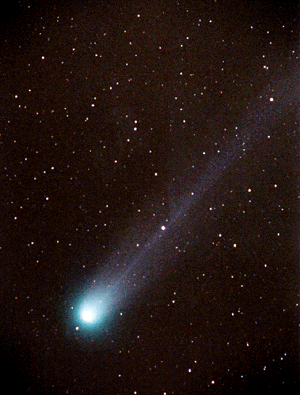Astronomy Picture of the Day
Discover the cosmos!
Each day a different image or photograph of our fascinating universe is
featured, along with a brief explanation written by a professional
astronomer.
March 26, 1996

What are Comet Tails Made Of?
Credit:
Jim Martin, Huntsville AL, Courtesy
"Night of the
Comet"
(NASA
/ Ames)
Explanation:
The tail of comet Hyakutake,
visible in this
recent colour image,
is composed of dust and gas driven off the
icy comet nucleus by the Sun's heat and
blown away by the solar wind.
Bathed in solar ultraviolet light,
the gas molecules break down and
are excited, producing a characteristic glow.
This glow is responsible for visible
light from the tail and
astronomers using spectroscopes can identify
the compounds involved.
The close passage of Hyakutake presents an excellent
chance to use this technique to
explore the composition of its tail.
Typical comet gas tail constituents are
simple combinations of hydrogen, carbon, nitrogen, and oxygen - for example,
H20 (water), CO (carbon monoxide), and CN (cyanogen) are common.
In fact, the poisonous CO and CN
compounds were seen in the spectrum of Halley's comet during
its 1910 apparition. This caused
some public concern at the time as
the Earth was expected to pass through Halley's tail!
However, stretching for millions of miles, comet tails
are extremely thin and tenuous and don't pose a danger to
the Earth's atmosphere.
Latest Comet Hyakutake images:
JPL,
Tomorrow's picture: How Much is That Comet in the Window?
<
Archive
| Index
| Search
| Calendar
| Glossary
| Education
| About APOD
>
Authors & editors:
Robert Nemiroff
(MTU) &
Jerry
Bonnell (USRA)
NASA Technical Rep.:
Jay Norris.
Specific rights apply.
A service of:
LHEA
at
NASA/
GSFC
&:
Michigan Tech. U.
